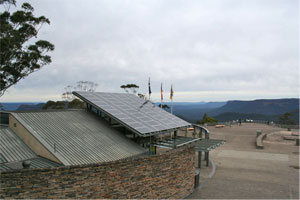Water and Renewables on World Heritage Site.
The Blue Mountains Sustainable Precinct project established sustainable solutions to water and energy use at three large-scale, high profile sites in Katoomba: Echo Point Visitors Centre; Blue Mountains Cultural Centre; and the adjacent Civic Centre.
The three project sites showcase working examples of how innovative design can reduce energy and water use and help manage urban impacts on the surrounding internationally recognised Greater Blue Mountains World Heritage Area, which includes the Blue Mountains National Park.
Key Initiatives
The Echo Point precinct attracts more than three million visitors per year. Key initiatives at this site included:
- solar panels (10 kW system) to produce 18 250 kWh of electricity per year
- stormwater harvesting for toilet use
The Blue Mountains Cultural Centre features a World Heritage interpretation centre highlighting the potential impacts of climate change on the surrounding Greater Blue Mountains World Heritage area. Key initiatives at this site included:
- energy efficient design features such as double brick air cavity walls, double glazed windows, and fully insulated roofing
- a building management control system, including an energy efficient air conditioning system
- energy efficient, gas-fired hot water heaters and solar hot water system
- rainwater tanks
- stormwater harvesting and treatment of runoff in rooftop and rain gardens
- solar panels (10kW system) to produce 18 250 kWh of electricity per year
The redevelopment of the Katoomba Civic Centre achieved a new public connection to the planned Blue Mountains Cultural Centre, as well as upgrading the well-used community facilities in the Civic Centre. Key initiatives at this site included:
- a 90 000L onsite detention tank for storm water harvesting and reuse
- solar panels (10 kW system) to produce 18 250 kWh of electricity per year
- a solar hot water system
Community engagement
Interactive displays, signage, interpretive tours and educational material provide information to the millions of visitors who come to these iconic sites. Visitors are prompted to think about sustainable living and how to better manage their own water and energy use.
Estimated annual savings
Water: 14.4 million litres
Energy: 1 985 771 kilowatt hours
CO2 emissions: 1 767 tonnes
















